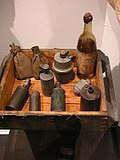Top Qs
Timeline
Chat
Perspective
Satchel charge
Thrown explosive combat device From Wikipedia, the free encyclopedia
Remove ads
A satchel charge (or bundle charge, for improvised forms) is a demolition device, primarily intended for combat, whose primary components are a charge of dynamite or a more potent explosive such as C-4 plastic explosive, a carrying device functionally similar to a satchel or messenger bag, and a triggering mechanism; the term covers both improvised and formally designed devices.
Uses
Summarize
Perspective
In World War II, combat engineers used satchel charges to demolish heavy stationary targets such as rails, obstacles, blockhouses, bunkers, caves, and bridges.
The World War II–era United States Army M37 Demolition Kit contained eight blocks of high explosive, with two priming assemblies, in a canvas bag with a shoulder strap.
Part or all of this charge could be placed against a structure or slung into an opening. It was usually detonated with a pull igniter. When used as an anti-tank weapon, charges were sufficient to severely damage the tracks. 4 kg (8.8 lb) charges were enough to destroy medium tanks.
Wehrmacht soldiers also used Satchel charges as improvised solutions to destroy armored structures and vehicles.[1] They employed the Stielhandgranate for the purpose, which was called the Geballte Ladung (lit. 'Interconnected charge'),
The heads of a number of M24 grenades – their handles and fuses removed – would be strapped around a complete grenade, usually with simple rope, cloth, or metal wire, a solution initially invented during World War I using M15, M16 and M17 grenades.[1] These "bundle charges" could be crafted with up to six additional heads around the complete grenade, the most common styles being the addition of four or six M24 heads.[citation needed]
During the early years of World War II, there was little in terms of truly effective German handheld weaponry designed to fight hard targets such as armored vehicles and structures, and even later in the war this style of bundle grenade remained useful to the common Heer infantryman.[1]
Later in the Vietnam War, Vietcong and North Vietnamese soldiers assigned elite sappers to stealthily penetrate defenses of sites controlled by enemy forces. Often, this meant using satchel charges as well as Bangalore torpedoes to blast through barbed wire entanglements, minefields, structures, and other fortifications.
The later U.S. M183 Demolition Charge Assembly contained 20 lb (9.1 kg) of C-4 in each satchel, and could be used with a timed fuse. In the Second Battle of Fallujah in Iraq, U.S. M2 20 lb assault demolitions were used to collapse houses being used as fighting positions by insurgents.
Some special forces may use customized satchel charges designed to destroy their specific mission's target.
Remove ads
Gallery
- Two improvised satchel charges along with Sidolówka grenades and a Molotov cocktail, as used in the Warsaw Uprising
- Weapons used in the Winter War; the original Finnish satchel charge is on the left
- Bundle charge design for the Stielhandgranate 24
- Geballte ladung with demo grenades
See also
References
External links
Wikiwand - on
Seamless Wikipedia browsing. On steroids.
Remove ads



